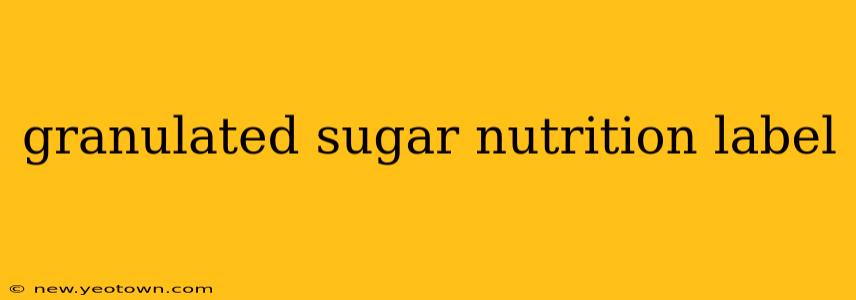Sugar. The very word conjures images of sweet treats, iced tea, and perhaps a slightly guilty feeling. But what exactly is in that seemingly simple bag of granulated sugar? Let's delve into the world of the granulated sugar nutrition label, unraveling its secrets and understanding what it really tells us.
Our story begins, not in a candy factory, but in a humble sugarcane field or a beet farm. From there, a complex process transforms these plants into the fine, crystalline granules we use every day. But the transformation doesn't end there. The nutrition label is the next chapter in our story, offering a glimpse into the nutritional composition of this ubiquitous ingredient.
What does a typical granulated sugar nutrition label show?
A standard granulated sugar nutrition label will primarily showcase the following:
-
Serving Size: Usually listed as 1 teaspoon (4 grams) or 1 tablespoon (12 grams). Knowing the serving size is crucial for understanding the nutritional information that follows.
-
Calories: Granulated sugar is almost entirely carbohydrates, translating to roughly 16 calories per teaspoon.
-
Total Carbohydrate: This is where the bulk of the nutritional information lies. Granulated sugar is essentially pure carbohydrate. You'll see this number listed in grams.
-
Sugars: This will be equal to or very close to the total carbohydrate value. This is because granulated sugar is almost entirely simple sugars (sucrose).
-
Other Nutrients: You'll likely see zeros across the board for other nutrients such as fat, protein, fiber, vitamins, and minerals. Granulated sugar provides minimal to no nutritional value beyond energy.
What are the main components of granulated sugar?
Granulated sugar is primarily sucrose, a disaccharide composed of glucose and fructose. This is what gives it its sweetness and is responsible for its rapid absorption and quick release of energy. While incredibly pure, trace amounts of other substances might be present depending on the refining process, but these are usually negligible in terms of nutritional impact.
Why are there no vitamins or minerals in granulated sugar?
This is because the refining process removes almost all naturally occurring vitamins and minerals found in the original sugarcane or beet. The final product is nearly pure sucrose.
Is there a difference in nutrition between white and brown sugar?
While both are primarily sucrose, brown sugar retains some molasses, giving it a slightly different flavor and a slightly higher mineral content compared to white sugar. The nutritional difference, however, is minimal. Both are still largely carbohydrates with minimal to no other nutrients.
Does granulated sugar have any health benefits?
While granulated sugar provides a quick source of energy, it lacks any significant health benefits. Excessive consumption is linked to various health problems such as weight gain, tooth decay, and an increased risk of certain chronic diseases. Moderation is key.
Is it true that granulated sugar is just empty calories?
Yes, it's accurate to say granulated sugar provides "empty calories." This means it provides energy (calories) without offering any significant nutritional value like vitamins, minerals, or fiber.
In conclusion, the granulated sugar nutrition label, while seemingly simple, tells a complete story. It's a story of pure energy, but also a reminder of the importance of mindful consumption and balanced nutrition. Understanding this story empowers us to make informed choices about our diet and overall health.

